Increasingly, visitors are traveling to and exploring our national parks by foot, bicycle, and other active modes, seeking opportunities to experience natural and cultural resources in new ways. The recently published National Park Service (NPS) Active Transportation Guidebook is helping parks, their partners, and gateway communities to meet visitor demand by implementing projects and initiatives that enhance active transportation. |
|
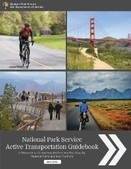 |
NPS developed the Guidebook with support from Volpe’s Public Lands team in collaboration with bicycle and pedestrian professionals, transportation experts, park staff, and partners including the Federal Highway Administration (FHWA). The Guidebook covers a number of topics and strategies to support walking and biking in National Parks and surrounding communities, from planning and deploying infrastructure such as pedestrian pathways and bike lanes, to evaluating and improving safety for active transportation modes, to offering activities and programs that provide park visitors the opportunity to bicycle or walk.
As visitation to national parks continues to increase, parks and communities will continue tackling a variety of visitor and resource management issues, such as vehicle congestion, poor air quality, and wild-life vehicle impacts. Providing new and active ways for visitors to arrive and explore these important places, without needing a car, can help to mitigate these negative impacts and make parks more bicycle and pedestrian-friendly.
Project Contact: Jessica Baas
Located in Colorado Springs, Colorado, Garden of the Gods (GoG) park is owned and managed by the City of Colorado Springs with support from the GoG Foundation. GoG was designated a National Natural Landmark by the National Park Service in 1971 and is characterized by vertical red rock geological formations of different shapes, sizes, and colors. Attracting up to six million visitors each year, GoG is the Colorado Springs region’s most popular destination.
As visitation has risen in recent years, the park has experienced significant congestion, particularly on summer weekends, with stop-and-go traffic for about one mile outside the entrance gate to the main parking lot. Concerned about safety and visitor experience, the City’s Parks, Recreation, and Cultural Services Department asked the Volpe Center to explore the feasibility of implementing a shuttle system during the peak season to help manage congestion.
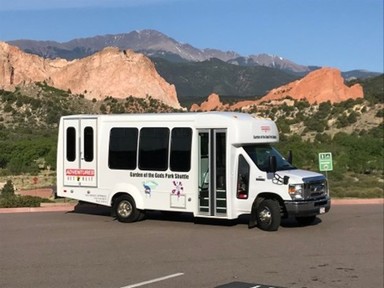 In its first season of operation, the Garden of the Gods park shuttle helped relieve congestion during peak months.
Over the course of a year, staff from Volpe’s Public Lands team conducted a site visit, met regularly with a core GoG project team and other key stakeholders, designed and analyzed a visitor survey, and held a public workshop to gather public input on implementing a pilot shuttle service. Volpe developed concepts for operations, estimated costs and ridership, and worked with the core team to narrow down the options to implement a short but frequent shuttle between the Visitor and Nature Center, a newly-developed parking lot in a nearby field, and GoG.
In May 2018, the City and a concessionaire rolled out this free service, which ran daily from Memorial Day weekend until Labor Day weekend. The shuttle was more successful than anticipated and removed over 20,000 cars from contributing to the congestion leading to the main parking lot. Based on survey results, it was clear riders were happy with the frequency and convenience of the shuttle, which the City is now looking to continue into the future.
Project Contact: Ben Rasmussen
As the Volpe Center’s longest-running public lands partner, the Public Lands team has supported the National Park Service (NPS) Northeast Region (NER) alternative transportation program since 2000. In 2015, when the NER Alternative Transportation Program Coordinator retired and the NER was unable to fill the position, Volpe staff were able to step in and help fill this role. Heather Richardson served as the Alternative Transportation Program Coordinator in fiscal years 2016 and 2017, and Katie Lamoureux served in the role in fiscal year 2018. During this time, Volpe helped fund and manage about $10 million worth of NPS’s alternative transportation projects in the NER. These have included a broad range of successful projects connecting communities to parks, managing congestion, easing parking shortages, improving air quality and soundscapes, and reducing wildlife/auto collisions. A few specific highlights include:
- Design and construction of a pedestrian network connecting Lowell National Historical Park to public transit and the City of Lowell’s urban residents;
- Implementation of a multi-year vehicle replacement program for Acadia National Park’s Island Explorer transit system; and
- Planning and design of a bicycle trail and infrastructure system to serve Cape Cod National Seashore.
Project Contacts: Heather Richardson and Katie Lamoureux
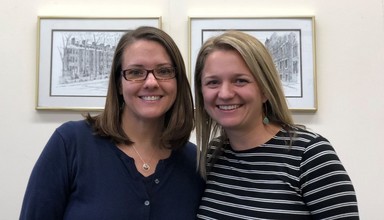 Heather Richardson (left) and Katie Lamoureux (right) have served as the NER Alternative Transportation Coordinators for the past three years.
Many public land units struggle with parking congestion – especially during peak times – and the range of viable congestion management strategies vary depending on the particular transportation needs of visitors and local residents. In the past several years, Kenai Fjords National Park (KEFJ) in Alaska has experienced increasing parking congestion in its Exit Glacier parking lot, especially on sunny summer days.
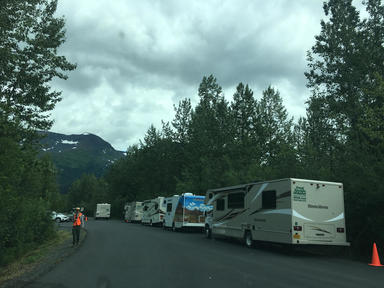 RVs park alongside the edge of the road in the Exit Glacier parking lot.
Exit Glacier is the only recreation site in KEFJ that is accessible by road, and as such, it is the primary visitor destination in the park. Because Exit Glacier is a two hour drive south from Anchorage and 13 miles north of the city of Seward, Alaska, it receives visitors arriving by passenger vehicle, recreational vehicle (RV), and tour bus. Private shuttles also provide access from Seward.
The Volpe Center’s Public Lands team is currently supporting a transportation study that will inventory and assess congestion management strategies for Exit Glacier, including potential business models for expanding transit access or incentivizing the use of transit by RV users to alleviate conflicts for parking at the site. The project will also consider other congestion management strategies, including parking area realignment, operations, and traveler information as well as recommendations to enhance the park’s data to inform future management decisions.
This project is managed by the Federal Highway Administration’s Western Federal Lands Division (WFL) and includes staff from Volpe, KEFJ, and the National Park Service Alaska Region (AKR). Project team staff participated in a site visit to KEFJ in August 2018 and expect to complete the final report in spring 2019.
As demonstrated in projects at Kenai Fjords, Garden of the Gods, and other public lands, parking lot and roadway congestion is a common issue that Volpe’s Public Lands team works to address with partner agencies. The Public Lands team meets weekly to share challenges and lessons learned so that all team members can use the knowledge gained in one project to help the next.
Project Contact: Erica Simmons
What public lands projects are you working on now?
I am assisting the U.S. Forest Service with development of their first ever National Long Range Transportation Plan (LRTP). This is a very interesting challenge for an agency with many contrasting conditions: relatively limited fiscal and staffing resources but over 300,000 miles of road, forest lands that serve both recreation and resource extraction endeavors, and a system that provides critical ecosystem services such as water quality management and wildlife habitat. The LRTP provides an excellent opportunity for the agency to articulate the role of transportation in serving and balancing these various complimentary and sometimes competing needs. I am also helping the National Park Service implement their LRTP program and strategize about ways to better integrate regular criteria-driven performance-based planning and programming.
What types of projects outside of public lands do you work on?
I work with the Federal Highway Administration’s (FHWA) Transportation Planning Capacity Building program (TPCB). This program provides a clearinghouse of planning-related resources and services, including the TPCB Peer Program, for which I manage several peer exchanges on various planning topics per year. A recent exchange included a symposium on health and active transportation that used short documentary videos and panel discussions in lieu of formal presentations to stimulate discussion on relevant subtopics. I am currently planning an exchange for Arlington County, VA, that will bring together regional and national peers with expertise in the use of low-traffic stress (LTS) analysis for planning and implementation of bicycle networks. I have also assisted with FHWA’s Urban Freight, Transportation Performance Management, and Vision Zero programs, which allow me to apply my previous professional experiences as a planner, urban designer, and street designer working in private practice and for the City of San Francisco’s Livable Streets subdivision.
What are your fondest memories of public lands?
Growing up, I recall a few trips to local state parks and one trip to Yosemite, which was my first exposure to the thrill junkies that scale those endless rock walls in the valley; an urge I have never known. My favorite sport has always been mountain biking since I grew up riding around the gorges and wooded parks in upstate New York. I was lucky enough to live in northern California for 10 years during which time I had access to local, state, and federal public lands in Santa Cruz, Marin County, Tahoe, and my backyard in the Berkeley-Oakland hills. Now that I’ve gotten older and am back in root- and rock-strewn New England, I broke down and got a dual suspension mountain bike and enjoy bouncing around local trails; I also enjoy not starting every bike ride with a 1,500+ foot climb. I do a fair bit of bicycle touring/camping and try to include as much public land as possible on the routes by using rail trails, carriage roads, and double track. My least fond memory is a few weeks ago when a public lands tree fell on my bicycle as I was getting ready to go for such a ride. Fortunately, I still got to sleep in a hammock by a river, so that was nice.
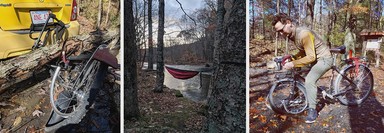 Jonah's former bicycle, and a nice place to spend the night in Hudson Valley, NY.
What new public land have you discovered since working at Volpe?
Since I work on national-scale Public Lands Team projects, there isn’t much reason to travel to specific parks. That is something I’d like to change, certainly for travel reasons, but more so to become more familiar with transportation context and challenges for our sponsors in the field.
What’s the most unique, interesting, or strangest job you had before working at Volpe?
I was the last paper boy in my neighborhood before the route was consumed by the trend toward papers delivered by minivan. I delivered the afternoon paper because there was enough readership to warrant two editions per day! In case you can’t remember when that was, here’s a hint: I delivered the papers on roller blades.
If you were to have a job that wasn’t transportation or public lands related, what would it be?
I would hope to have still escaped the fate of architect—my first profession. I’d most likely still be an urban planner but in a different related field, such as transit-oriented development or urban design. Although I’ve always like the idea of advertising…
Contact: Jonah Chiarenza
|